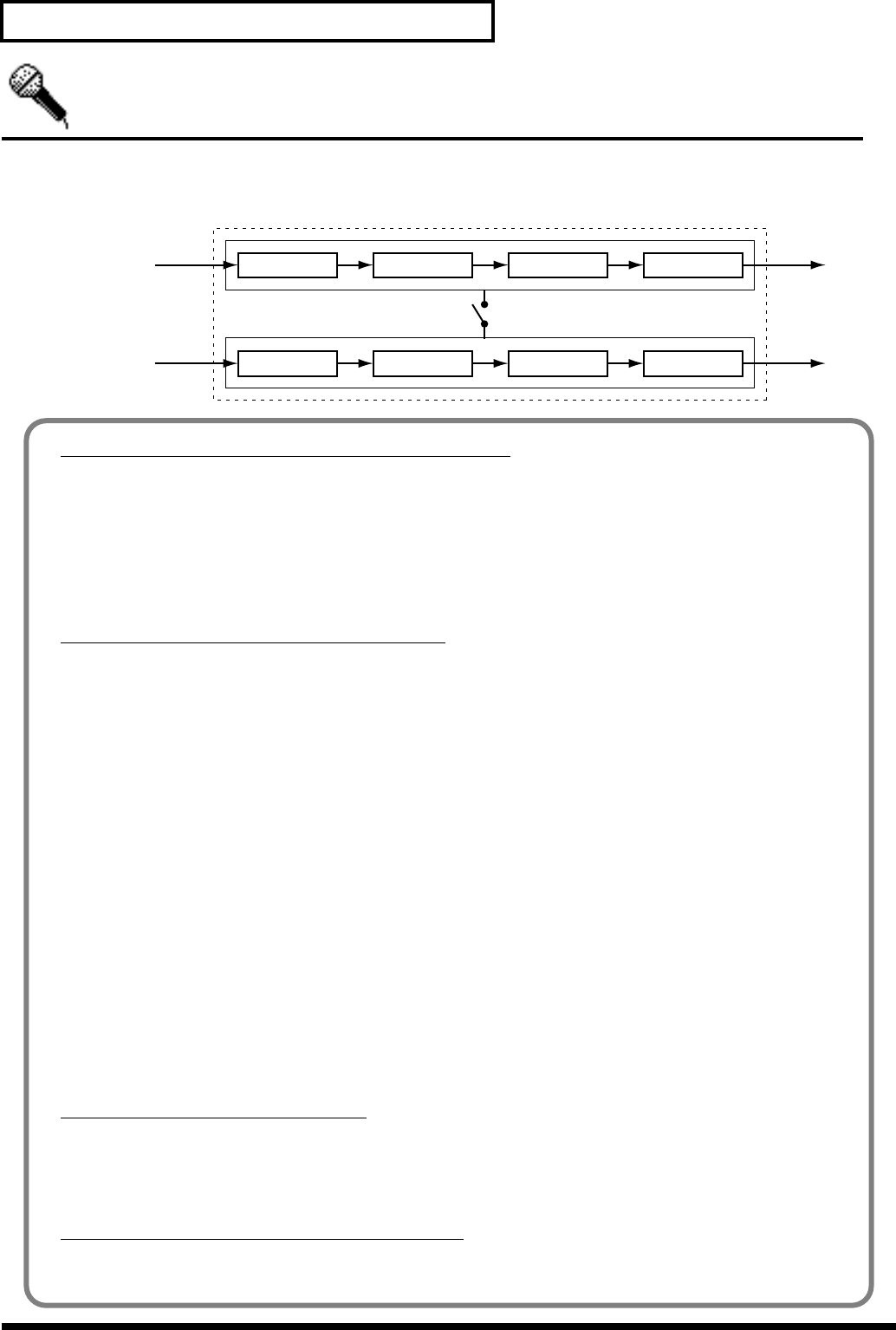
72
Algorithm List
Mic Modeling (Microphone Modeling)
This modifies sound that was recorded by a conventional dynamic mic, lapel mic or direct line, causing it to sound
as though it had been recorded by an expensive condenser mic or a special studio mic. The mic simulator can add
effects of proximity or distance.
fig.08-67
Mic Converter A
BassCut A Distance A Limiter A
Mic Converter B
Bass Cut B Distance B Limiter B
Link
Input A
Input B
Output A
Output B
Selecting the microphone used for recording.
Input of Mic Converter selects the type of microphone to be used recording.
DR-20: Roland DR-20 (dynamic microphone manufactured by Roland)
Sml.Dy: Small Dynamic Microphone (dynamic microphone used for instruments and vocal)
Hed.Dy: Head-worn Dynamic Microphone (headset-type dynamic microphone)
Min.Cn: Miniature Condenser Microphone (very small condenser microphone)
Flat: Line input
C3000B: AKG C3000B (Condenser microphone manufactured by AKG)
Microphone types that can be modeled
The characteristics of the low-end general-purpose microphone are converted into the characteristics of the High-
end microphone for studio application. You can add sound quality changes to already recorded sounds just as if
a different type of microphone were used or if they were recorded at a different distance. In addition, it is possible
to add microphone characteristics to line-recorded instrumental sounds. These characteristics can be set up by
selecting the relevant value for Out of Mic Converter.
Sml.Dy: Dynamic microphone for general musical instruments and vocal sounds. Ideal for a guitar
amplifier and snare drums.
Voc.Dy: Dynamic microphone for standard vocal sounds. Characterized in middle frequency band sounds
with tension. Suited for vocal.
Lrg.Dy: Dynamic microphone with a extended low frequency band. For bass and tom drums.
Sml.Cn: Small condenser microphone for musical instruments. Characterized in bright High frequency
band sounds. For metal percussion and acoustic guitars.
Lrg.Cn: Condenser microphone with flat characteristics. For vocal, narration and live musical instruments.
Vnt.Cn: Vintage condenser microphone. For vocal and live musical instruments.
Flat: Microphone with flat frequency response. For removing peculiarity of the microphone used for
recording sounds.
* When a condenser-type mic is selected in OUT, low-range noise transmitted through the mic stand may be
accentuated due to the mic’s low range characteristics. In such instances, either cut out any unnecessary low end
with bass cut filter, or equip the mic stand with an isolation mount (a mic holder with rubber or other shock
absorbing material).
* The “Lrg.Dy” and the “Lrg.Cn” of the Out parameter are valid only if the In parameter is set to “Min.Cn.”
Proximity effect of microphone
In nature, a microphone tends to extend the low frequency band characteristics when placed close to the sound
source. This is called proximity effect. This effect can be modeled in Proximity Effect (Prox-Efect). Set the
parameter to a positive (+) value for a shorter distance to the sound source and a negative (-) value for a longer
distance to the sound source. Time of Distance models the time difference due to distance from the sound source.
Controlling Channels A and B separately
Setting Link On enables simultaneous control on the 4-Band Parametric Equalizer via Channel B according to the
settings on the Channel A side. To control Channels A and B separately, turn Link Off.
2400_app_e.book 72 ページ 2005年4月28日 木曜日 午後1時14分


















